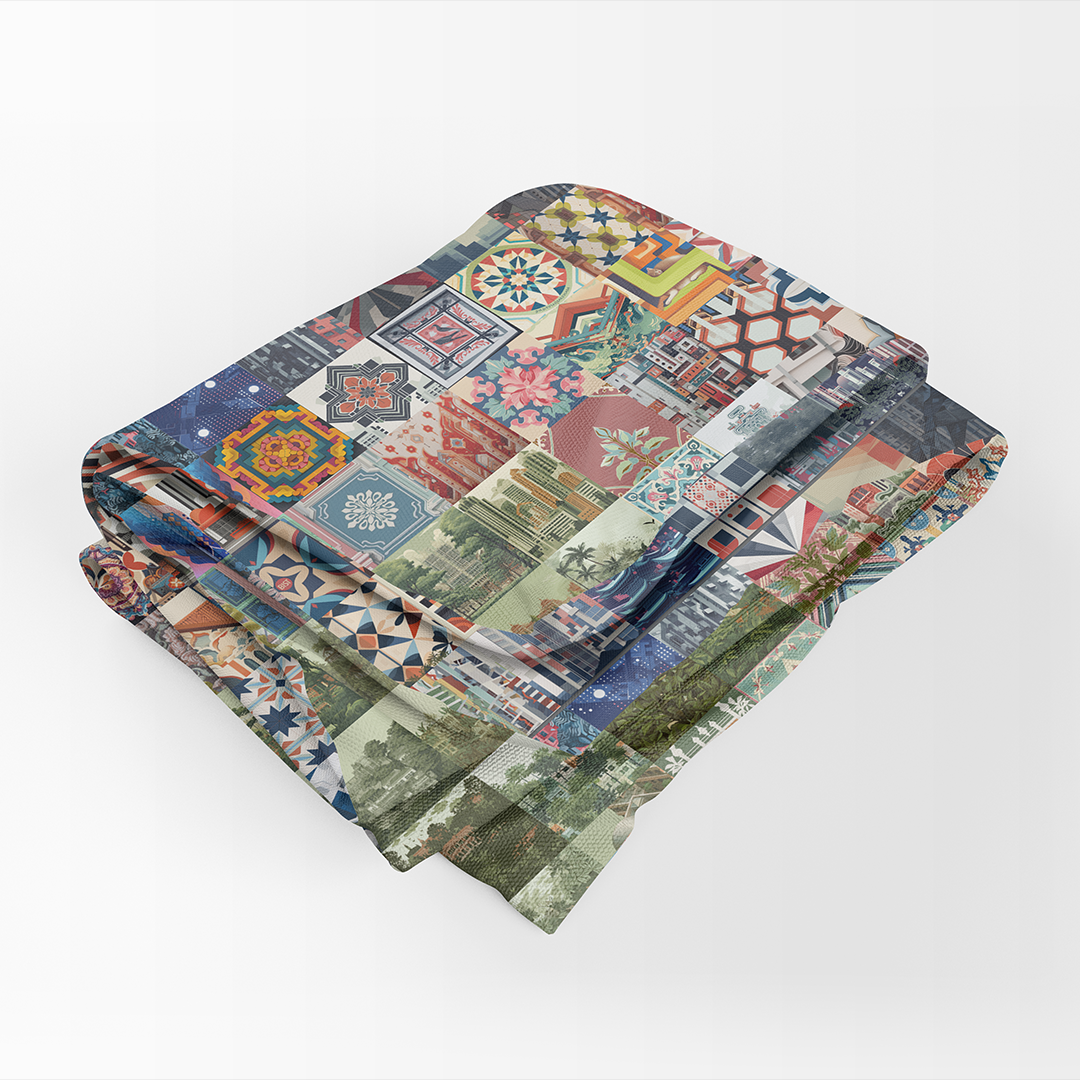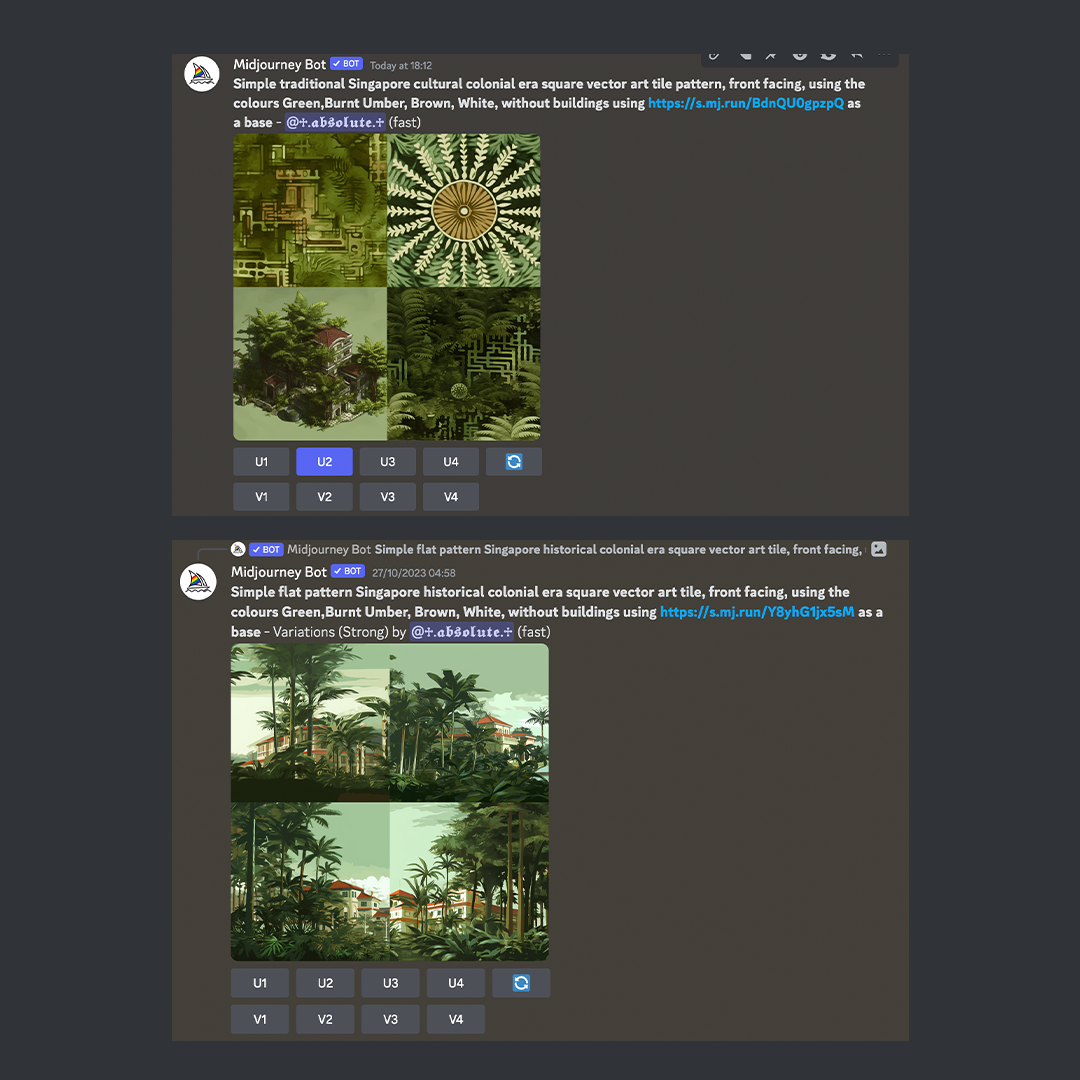Findings
Our findings highlight the uniqueness of each location, revealing distinct color schemes and structures/motifs. Overall, a recurring pattern emerges, providing invaluable insights for prompt creation and the crafting of art tiles that authentically depict Singaporean cultural locales. This process involved feeding images through color.adobe, identifying repeated colors across images, while motifs and structures were revealed through strategic croppings. For instance, Joo Chiat showcased muted pastels of pink, blue, and green, while Kampung Glam exuded regal tones of blues, oranges, gold, and red, as illustrated in the images below.
The significance of unique recurring structures became evident, complemented by brief research about each place, aligning the captured visuals with the essence of each location. Orchard Road, for example, reflected its descriptors, mirroring the cropped images and embodying the character of a 'luxury' and 'touristy' hub.
Beyond the intricacies of the process, the generation aspect proved captivating. Midjourny AI demonstrated the ability to recognize elements within the cropped images and skillfully transform them into art tiles. This transformative capability spans from capturing small detailed elements to the representation of building and object structures, adding an extra layer of fascination to the creative generation process.
Insights we gained
The Cultural Cocoons Data Spaces project in Singapore successfully harnesses AI image generation and data-driven methodology to preserve and celebrate the city-state's rich cultural tapestry. By focusing on key cultural hubs and employing precise image capture parameters, the project ensures the selection of culturally significant scenes, enhancing the accuracy of the representation. Utilizing web-based color detection tools and the Adobe platform, vibrant colors inherent to each image are documented, enriching the visual narrative.
The Midjourney AI's remarkable accuracy in capturing photograph elements proves pivotal in generating unique textile patterns for each image. The resulting artifact, a multicultural identity-themed tile quilt, reflects Singapore's diverse heritage. Starting with Fort Canning and extending to modern influences like Orchard, the quilt symbolically tells a journey through Singapore's history, showcasing traditional motifs and symbols.
This tangible representation fosters a deeper connection and appreciation for the city's intricate cultural fabric, achieving the project's goal of creating a visual homage to Singapore's harmonious diversity.
Design decisions
The very start of our project involved the development of a color detection system, built entirely from scratch, encompassing the coding process and the capture of colors. We wanted to extract the colours from a place and study the ‘colored essence’ of the location. This journey then evolved into the desire of the exploration of the bus route to detect colours along cultural sights, followed by the recording of scenes and the utilization of STRAVA for location data by simply walking around iconic heritage and cultural sites.
We integrated archival images into our process, and the concept of a ‘cultural art tiles’ emerged, inspired by Singapore's identity as a tapestry of cultures. This analogy guided our intention to create a textile or quilt that encapsulated the diverse cultural elements.
Transitioning from paper cloth to actual cloth, our design decisions drew substantial inspiration from the cataloging approach of IKEA. Ultimately, we envisioned a captivating video advertisement illustrating the transformative journey of images evolving from generated tiles to a beautifully patterned quilt, aiming to convey the essence of our project's narrative. Below are some of the mockups we made of the quilt with the generated art tiles along with an animatic video that servs as a moving storyboard for our product shoot and film.
Challenges
Throughout our 7-week Data Spaces project, we encountered various challenges and adaptations: Technology Limitations: Insufficient tools, such as the color sensor for Arduino, limited our exploration of color detection. The code found for P5js and webcam couldn't detect multiple colors simultaneously and lacked color registration.
The project underwent several crucial adaptations to enhance its overall effectiveness. Initially, the project brief was modified in response to challenges encountered in video color detection, as well as concerns about the repetitive design outcome. Building on lessons learned from the overworked artifact design, which featured a perlin field wave, we recognized its unoriginality and lack of meaningful connection to the project's overarching objective. Furthermore, the project's scope was identified as broad and confusing, leading to challenges in establishing a clear correlation between the defined objective and the ultimate product. Progress was impeded by undefined parameters, highlighting the need for clearer project parameters to guide the team towards successful project outcomes.
The project faced notable challenges in image generation, primarily stemming from cropping limitations that adversely impacted the overall quality of the outcome. A significant number of images predominantly displayed the sky due to these constraints. In response, adjustments were made to the image prompts. Specifically, the term "traditional" was removed, and the focus shifted towards eliciting simple patterns. The revised prompts now call for the use of three adjectives to vividly describe a place. These modifications aimed to address the cropping limitations and enhance the diversity and richness of the generated images.
The process of material and fabric selection for the blanket artifact involved a series of experiments. Initially, canvas paper was considered, but concerns emerged regarding its visual and textural quality post-printing. In response to these concerns, the team explored the option of using fabric due to its affordability and potential for higher quality. However, this approach presented a challenge as it introduced printing time constraints. Overall, the challenges encountered in material and fabric selection were part of a broader array of issues, including technical constraints, struggles with image generation, and necessary adjustments in project objectives and artifacts.
Feedback
The early stages of feedback emphasized the importance of exploration, cautioning against premature narrowing of focus. Positive reception was given to the idea of AI-generated images based on text inputs, with a suggestion to explore multiple ideas. While the project's direction was appreciated, there was a consensus that the scope was too broad, prompting a recommendation for increased focus. A miscommunication about testing in different locations led to a proposal to narrow the scope and clarify project goals. Further suggestions included simplifying the project concept, establishing clear criteria for color selection, exploring creative data extraction methods, incorporating image editing sliders, increasing the number of images, and considering material choices. Concerns about time investment were raised, with advice to define clear project objectives for streamlined development.
The later stages of feedback encourages exploration of various tools, framing the project as a form of sampling, with emphasis on consistent parameters and precision. Concerns about color accuracy post-printing were raised, urging a test print before finalizing the outcome. Regarding the tapestry, suggestions included reconsidering canvas material and exploring alternatives like tiles or wallpaper for a more authentic representation. Positive feedback on the blanket's printed outcome emphasized taking time for sewing and not overthinking the catalog. The recommendation to document the making process was highlighted, along with the generous offer of studio permission for production.
Overall, the feedback focuses on streamlining the project, optimizing data collection, ensuring material authenticity, and emphasizing clear objectives and documentation for the final outcome.
In the end, we needed to remind ourselves of the concept and produce and pay homeage to the heart of the project; The Tapestry of Cultures in Singapore.

Achievements
In our drive for efficiency, we implemented techniques, notably using Photoshop's 'actions' tool for faster, more convenient, and consistently accurate photo sampling compared to manual methods. Simultaneously, we tailored a set of keywords for optimal AI image generation, creating a versatile base prompt applicable across various tasks. To convey our project's objective, we utilized diverse media and prioritized finding the ideal fabric for quilt creation. Inspired by IKEA, we incorporated a cataloguing aesthetic into a side artifact for effective presentation.
Additionally, we take pride in understanding AI's workings, achieving prompt-making success with visually impactful tiles. This involved establishing a rhythm and structure, using keywords smartly and concisely for more efficient outcomes.








